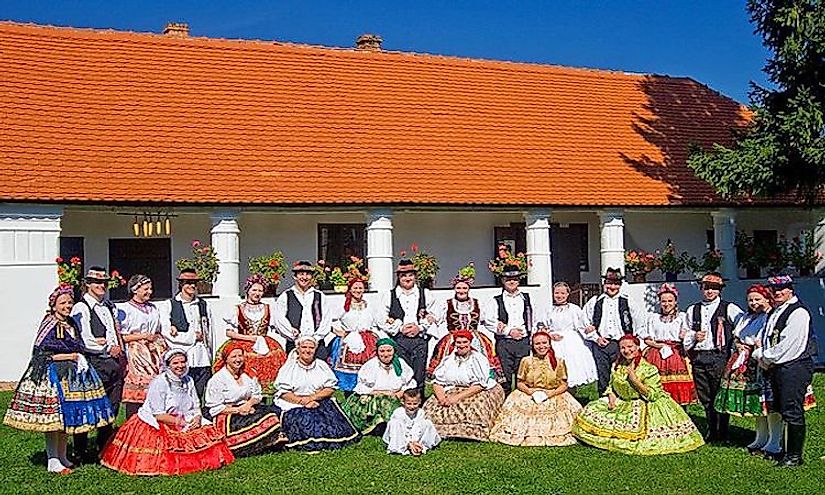Ethnic Groups Of Hungary

Hungary is a European country located in Central Europe, bordering Romania, Croatia, Slovenia, Serbia, Slovakia, Ukraine, and Austria. The largest and capital city of Hungary is Budapest. Hungary has a population of about 10 million people and their official language is Hungarian. For centuries the Slavs, Celts, Gepids, Avars, and Romans were responsible with laying the foundation for ethnic diversity in Hungary. Most Hungarians identify as ethnically Hungarian, among smaller minorities of Roma, Germans, and other peoples.
Ethnic Groups Of Hungary
Hungarians
Hungarians refers to the people of the nation of Hungary and refers to the largest ethnic group in the country, and to wade off the confusion the Hungarians ethnic group refer to themselves as Magyar likely to have been derived from the name Megyer, a notable Hungarian tribe. Most Hungarians live around parts of the area that was formerly known as the Kingdom of Hungary. Hungarians are said to have originated from the West of Ural Mountains migrating into areas around the Don River between the 4th and 6th centuries AD. The Hungarian population quickly declined during the period of the Ottoman rule and the influx of new European settlers such as the Germans. Between 1918 and 1920 the Treaty of Trianon saw the Kingdom of Hungary cut into several parts leaving only a small portion and a third of the Hungarians as minorities in the neighboring countries, but during the 20th-century the remaining Hungarians increased in numbers. Currently, Ethnic Hungarians account for 83.7% of the population.
Romani
The Romani ethnic group in Hungary is known as the Romani Hungarians and is of Romani descent. The Romani are believed to have originally come from Punjab and Rajasthan. Romani people first migrated into Hungary during the 14th and 15th centuries fleeing from the Turks. During the 18th century, Empress Maria Theresa prohibited the Romani from marrying gave orders for their children to be taken away while Emperor Joseph II banned the use of Romani language in order to forcefully assimilate them into the Hungarian culture and the end result was the Romani abandoning their culture and customs and forgetting their original language. The Romani accounts for 3.1% of the population in the country.
Germans
The ethnic Germans of Hungary are a minority group known as Germanic Hungarians or the Danube Swabians. The ethnic Germans migrated into Hungary in the year 1000 when the German- born queen to King of Hungary Stephen I and her knights entered Hungary. What followed were waves of Germanic-speaking people migrating into Hungary from settlers to deliberate settlement policies put in favor of the Germans. All through the 19th century, the Germans established a strong industrial community through masonry, glass blowing and foundries which saw the Hungarian government establish ways to assimilate the ethnic Germans into the Hungarian culture and retain their economic power. After World War II a total of 239,000 Germans were deported from Hungary due to the Nazi association while those who took up Hungarian nationality were spared from deportation and completely made part of the Hungarian community. Ethnic Germans in Hungary account for 1.3% of the population.
Slovaks
According to the Census, Slovaks come in third as the largest minority group in Hungary after the Romas and Germans. Initially, the Slovaks occupied territories which included the Great Moravian parts between the 9th and 10th century before they were included into the Hungarian Principality. During the Turkish wars when the Hungarian Kingdom was split into three, the areas occupied by the Slovaks mostly became part of Habsburg. Between the 18th and 19th centuries, Slovak migrants decided to settle in other countries that later became present-day northern Hungary while others settled in the southern region. At the moment, Slovaks account for 0.3% of the population.
Decline Of Ethnic Groups In Hungary
The Treaty of Trianon post-World War I played a significant role in the decline of ethnic groups in Hungary. During this time Hungary lost more than 70% of its territory, 58% of the Hungarian population and 32% of the Magyar also known as ethnic Hungarians. The World War II also resulted in the decline of the Hungarian ethnic minority groups especially the Germans who were either deported from Hungary or killed by their Nazi counterpart for denouncing their German association.
Ethnic Groups Of Hungary
| Rank | Ethnic Group (Self-Identified) | Share of Population in Hungary |
|---|---|---|
| 1 | Hungarians | 83.7% |
| 2 | Romani | 3.1% |
| 3 | Germans | 1.3% |
| 4 | Slovaks | 0.3% |
| 5 | Romanians | 0.3% |
| 6 | Croats | 0.2% |
| Other or Undeclared | 11.1% |











